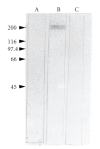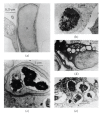Immunological and therapeutic strategies against salmonid cryptobiosis
- PMID: 20052385
- PMCID: PMC2801003
- DOI: 10.1155/2010/341783
Immunological and therapeutic strategies against salmonid cryptobiosis
Abstract
Salmonid cryptobiosis is caused by the haemoflagellate, Cryptobia salmositica. Clinical signs of the disease in salmon (Oncorhynchus spp.) include exophthalmia, general oedema, abdominal distension with ascites, anaemia, and anorexia. The disease-causing factor is a metalloprotease and the monoclonal antibody (mAb-001) against it is therapeutic. MAb-001 does not fix complement but agglutinates the parasite. Some brook charr, Salvelinus fontinalis cannot be infected (Cryptobia-resistant); this resistance is controlled by a dominant Mendelian locus and is inherited. In Cryptobia-resistant charr the pathogen is lysed via the Alternative Pathway of Complement Activation. However, some charr can be infected and they have high parasitaemias with no disease (Cryptobia-tolerant). In infected Cryptobia-tolerant charr the metalloprotease is neutralized by a natural antiprotease, alpha2 macroglobulin. Two vaccines have been developed. A single dose of the attenuated vaccine protects 100% of salmonids (juveniles and adults) for at least 24 months. Complement fixing antibody production and cell-mediated response in vaccinated fish rise significantly after challenge. Fish injected with the DNA vaccine initially have slight anaemias but they recover and have agglutinating antibodies. On challenge, DNA-vaccinated fish have lower parasitaemias, delayed peak parasitaemias and faster recoveries. Isometamidium chloride is therapeutic against the pathogen and its effectiveness is increased after conjugation to antibodies.
Figures









References
-
- Woo PTK. Protective immunity in fish against protozoan diseases. Parassitologia. 2007;49(3):185–191. - PubMed
-
- Woo PTK, Bruno DW, Lim LHS. Diseases and Disorders of Finfish in Cage Culture. Wallingford, UK: CABI; 2002.
-
- Van Muiswinkel WB, Vervoorn-Van Der Wal B. The immune system of fish. In: Woo PTK, editor. Fish Diseases and Disorders, Volume 1: Protozoan and Metazoan Infections. 2nd edition. Wallingford, UK: CABI; 2006. pp. 678–701.
-
- Ardelli BF, Woo PTK. Immunocompetent cells and their mediators in Fin Fish. In: Woo PTK, editor. Fish Diseases and Disorders, Volume 1: Protozoan and Metazoan Infections. 2nd edition. Wallingford, UK: CABI; 2006. pp. 702–724.
-
- Woo PTK. Cryptobia (Trypanoplasma) salmositica and salmonid cryptobiosis. Journal of Fish Diseases. 2003;26(11-12):627–646. - PubMed
Publication types
MeSH terms
Substances
LinkOut - more resources
Full Text Sources
Miscellaneous

